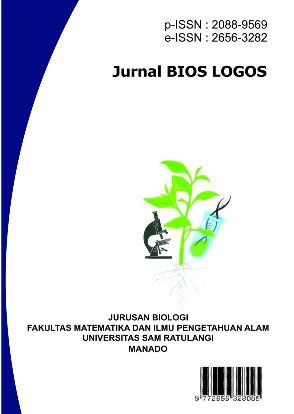Performance of Laying Chickens with Feed Additive Cinnamon Flour (Cinnamomum burmanni (Nees & T.Nees) Blume)
DOI:
https://doi.org/10.35799/jbl.v14i1.53654Keywords:
health performance, laying hens, cinnamon flour, feed additive sourceAbstract
Chickens are important commodities due to human need eggs to meet animal protein. Increasing of resistance of bacteria to synthetic antibiotics and consumer understanding of health and food safety have stimulated use of antibiotic growth promoters (AGP) in poultry industry. AGP applied sustainable feed management steps to improve gut health and poultry growth performance. Cinnamon, one of the spices as a natural product. This useful source due to antioxidants, anti-microbial, anti-inflammatory, antifungal, and hypo-cholesterolemic effects and its capability to activate digestion enzymes in intestine. This research aimed to analyze the performance of laying chicken eggs fed with cinnamon flour. The treatments used were cinnamon flour with levels R0 (basal ration, without cinnamon flour/CF, R1 (99.5% BR+ 0.5% CF), R2 (99% BR+ 1% CF), R3 (98% BR + 1.5 % CF), and R4 (98% BR + 2% CF). Data were analyzed with Completely Randomized Design and Duncan's test. Variables were ration consumption, Hen Day Production/HDP and ration conversion. Results showed that adding 2% cinnamon flour significant effect on feed consumption, HDP (P< 0,01) but insignificant on ration conversion (P>0.05). Cinnamon flour as feed additive source up to 2% level can increase the performance of laying hens.
References
Ali A, Ponnampalam EN, Pushpakumara G, Cottrell JJ, Suleria HAR, Frank RD. (2021). Cinnamon: a natural feed additive for poultry health and production: a review. Animals.11(2026):1-11. https://doi.org/10.3390/ani11072026.
Antasionasti I, Jayanto I. (2021). Aktivitas antioksidan ekstrak etanol kayu manis (Cinnamomum burmani) secara in vitro. Jurnal Farmasi Udayana. 10(1): 38-47. DOI:10.24843/JFU.2021.v10.i01.p05.
Carrasco JMD, Casanova NA, Miyakawa ME. (2019). Microbiota, gut health and chicken productivity: what is the connection? Microorganisms. 7(374):3-15. DOI: 10.3390/microorganisms7100374.
Chou O, Ali A, Subbiah V, Barrow CJ, Dunshea FR, Suleria HAR. (2021). LC-ESI-QTOF-MS/MS characterisation of phenolics in herbal tea infusion and their antioxidant potential. Fermentation. 7(2):1–24. https://doi.org/10.3390/fermentation7020073
Dilawar MA, Hong SM , Dhanushka R, Yang EJ , Seo YS , Park HS ,Yang CJ.(2021). Egg quality parameters, production performance and immunity of laying hens supplemented with plant extracts. Animals. 11 (4):975. DOI: 10.3390/ani11040975.
Dvorackova E, Snoblova M, Chromcova L, Hrdlicka P. (2015). Effects of extraction methods on the phenolic compounds contents and antioxidant capacities of cinnamon extracts. Food Sci. Biotechnol.24:1201–1207. https://link.springer.com/article/10.1007/s10068-015-0154-4.
Fahrullah F. (2021). Efek perendaman menggunakan bubuk kayu manis (Cinnamomum burmanni) terhadap kualitas interior telur itik.Jurnal Peternakan Sriwijaya. 10(2):19-28. DOI: https://doi.org/10.36706/JPS.10.2.2021.15131.
Irmayani, Daming H, Munir M, Fitriyani F, Asikin N.(2022). Pengaruh pemberian tepung kayu manis (Cinnamomum burmannii) dalam ransum terhadap bobot dan persentase karkas itik pedaging. Anoa: Journal of Animal Husbandry. 1(1): 32-38.DOI: https://doi.org/10.24252/anoa.v1i1.28277.
Lupu JSI, Wuri DA, Detha AIR. (2016). Perbandingan kualitas telur ayam kampung yang disimpan pada suhu ruang dan suhu lemari pendingin ditinjau dari tinggi kantung hawa, indeks kuning telur, indeks albumin, Haugh Unit dan Total Plate Count (TPC). Jurnal Veteriner Nusantara. 1(1): 46-52. DOI: https://doi.org/10.35508/jvn.v1i1.931.
Mehdi Y, Létourneau-Montminy M-P, Gaucher M-L,Chorfi Y, Suresh G, Rouissi T, Brar SK, Côté C, Ramirez AA, Godbout S. (2018). Use of antibiotics in broiler production: global impacts and alternatives. Anim. Nutr. 4(2): 170–178. DOI: 10.1016/j.aninu.2018.03.002.
Palinggi AF, Rasbawati R, Nurhapsa N, Irmayani I, Kadir MJ. (2022). Uji organoleptik daging itik (Anas domesticus) dengan penambahan tepung kayu manis (Cinnamomum burmani) dalam ransum. Journal Gallus Gallus. 1(1): 1-8. https://ojs.polipangkep.ac.id/index.php/gallus.
Pathirana R, Senaratne R. (2020). Cinnamon. In Cinnamon: Botany, Agronomy, Chemistry and Industrial Applications. Springer. https://doi.org/10.1007/978-3-030-54426-3_3.
Purwati D, Djaelani MA, Yuniwarti EYW. (2015). Indeks Kuning Telur (IKT), Haugh Unit (HU) dan Bobot Telur pada Berbagai Itik Lokal di Jawa Tengah. Jurnal Biologi. 4(2): 1–9. https://ejournal3.undip.ac.id/index.php/biologi/article/view/19405/18404.
Ribeiro-Santos R, Andrade MA, Madella D, Martinazzo AP, Moura LDAG, de Melo NR, Sanches-Silva A. (2017). A revisiting an ancient spice with medicinal purposes: cinnamon. Trends Food Sci.&Technol. 62(1):154–169. DOI:10.1016/j.tifs.2017.02.011.
Sayuti K, Yenrira R. (2015). Antioksidan Alami dan Sintetik (I). Andalas University Press. http://repository.unand.ac.id/23714/1/Kesuma Sayuti_Antioksidan Alami dan Sintetik OK.pdf.
Sharifi-Rad J, Song S, Ali A, Subbiah V, Taheri Y, Suleria HAR. (2021). LC-ESI-QTOF-MS/MS characterization of phenolic compounds from Pyracantha coccinea M.Roem and their antioxidant capacity. Cellu. Molec. Biol. 67(1):201-211.DOI: 10.14715/cmb/2021.67.1.29.
Sunarno S. (2018). Efek suplemen kulit kayu manis dan daun pegagan terhadap produktivitas puyuh petelur strain australia (Coturnix coturnix australica). Buletin Anatomi dan Fisiologi. 3(1): 89-96. DOI: https://doi.org/10.14710/baf.3.1.2018.89-96.
Downloads
Published
How to Cite
Issue
Section
License
Copyright (c) 2024 Florencia Sompie , Jein Riny Leke, Jacqueline Laihad , Hengky Kiroh , Nontje Kumajas, Ratna Siahaan

This work is licensed under a Creative Commons Attribution 4.0 International License.




